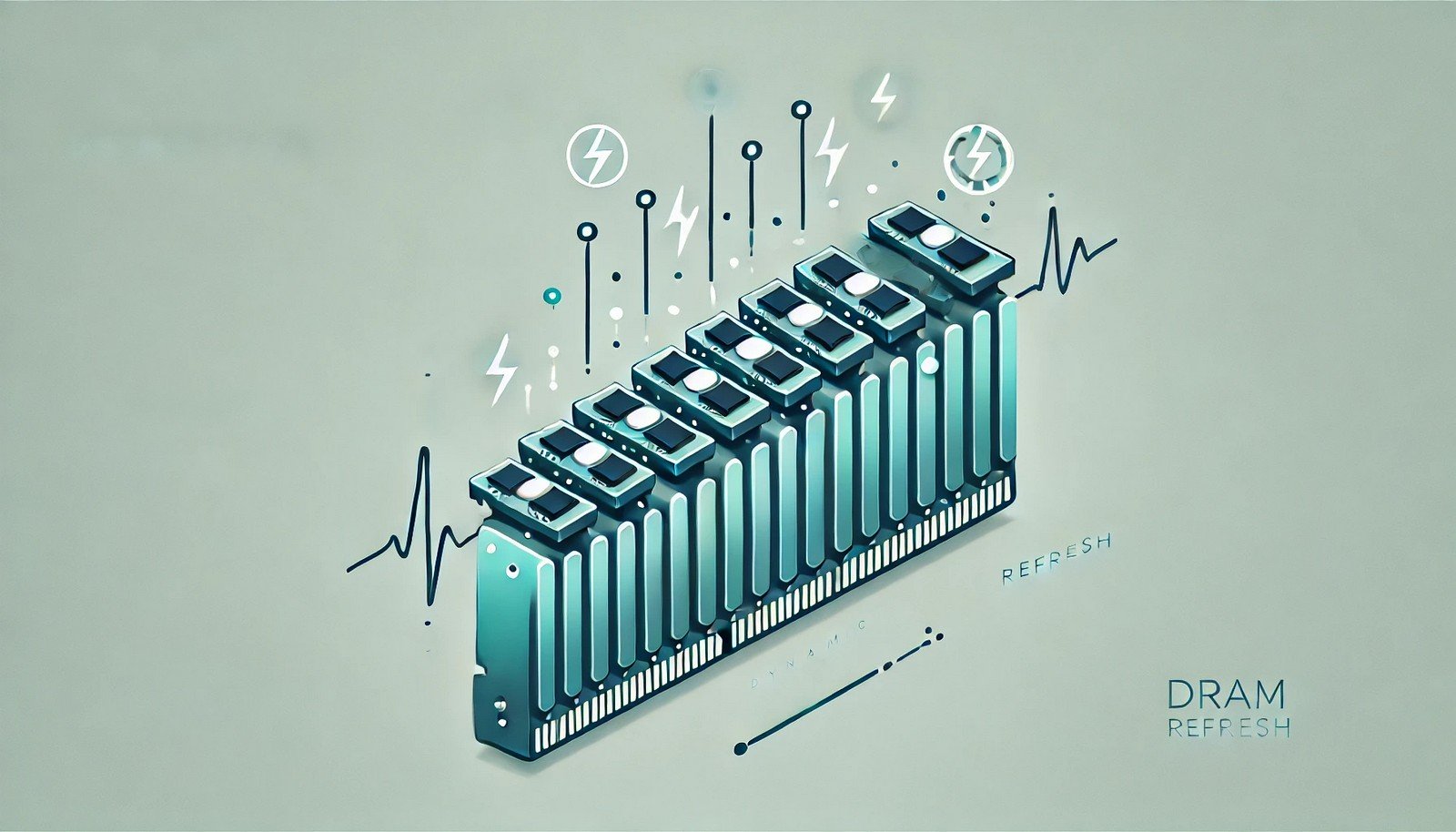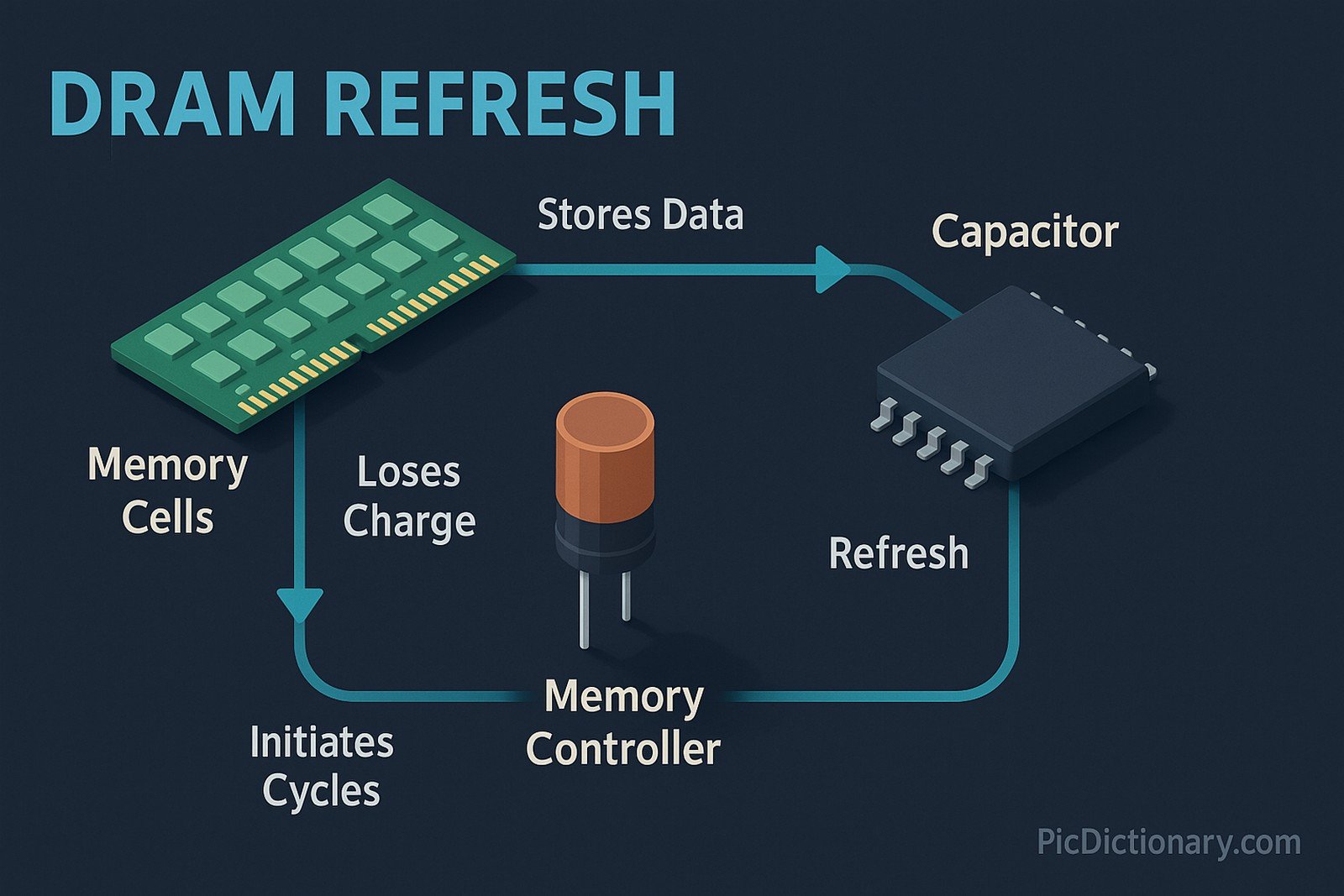DRAM Refresh
 (Representational Image | Source: Dall-E)
(Representational Image | Source: Dall-E)
Quick Navigation:
- DRAM Refresh Definition
- DRAM Refresh Explained Easy
- DRAM Refresh Origin
- DRAM Refresh Etymology
- DRAM Refresh Usage Trends
- DRAM Refresh Usage
- DRAM Refresh Examples in Context
- DRAM Refresh FAQ
- DRAM Refresh Related Words
DRAM Refresh Definition
DRAM (Dynamic Random-Access Memory) refresh is the process of periodically recharging memory cells to prevent data loss. Unlike static RAM, DRAM stores data in tiny capacitors, which gradually lose charge over time. If not refreshed regularly, the stored data fades away. DRAM refresh cycles are controlled by the memory controller, ensuring data integrity while balancing performance and power efficiency.
DRAM Refresh Explained Easy
Think of DRAM like a whiteboard where you write with disappearing ink. If you don’t rewrite the words often, they vanish! DRAM works similarly—each memory cell needs to be refreshed frequently so the data doesn’t fade away.
DRAM Refresh Origin
The concept of memory refreshing became critical with the development of DRAM in the late 1960s. IBM and Intel played significant roles in designing DRAM architectures that required periodic refresh cycles to maintain stored information. The necessity for refresh operations has persisted as DRAM technology has advanced.
DRAM Refresh Etymology
The term "refresh" comes from the act of restoring or replenishing something. In DRAM, it means restoring the electrical charge in memory cells so that data remains intact.
DRAM Refresh Usage Trends
With the rapid evolution of computing, DRAM refresh techniques have continuously improved to balance power efficiency and performance. Low-power DRAM variants, such as LPDDR, use optimized refresh cycles to extend battery life in mobile devices. In high-performance computing, minimizing refresh latency has become a priority to improve data processing speeds.
DRAM Refresh Usage
- Formal/Technical Tagging:
- Memory Management
- Computer Architecture
- Semiconductor Technology - Typical Collocations:
- "DRAM refresh cycle"
- "memory refresh rate"
- "refresh interval for DRAM"
- "self-refreshing DRAM"
DRAM Refresh Examples in Context
- Modern laptops use self-refreshing DRAM, reducing power consumption when idle.
- High-performance servers optimize DRAM refresh intervals to improve computing efficiency.
- Mobile devices use low-power DRAM refresh to extend battery life.
DRAM Refresh FAQ
- What is DRAM refresh?
DRAM refresh is the process of periodically recharging memory cells to retain stored data. - Why does DRAM need to be refreshed?
DRAM stores data in capacitors that lose charge over time, requiring refresh cycles to prevent data loss. - How often is DRAM refreshed?
Typically, DRAM is refreshed every few milliseconds, with the exact rate depending on temperature and memory type. - Does DRAM refresh impact system performance?
Yes, frequent refresh cycles can introduce slight latency, but modern memory controllers optimize refresh scheduling to minimize performance loss. - What is self-refresh in DRAM?
Self-refresh is a power-saving feature where the DRAM chip itself handles refresh cycles without needing constant control from the CPU. - How does temperature affect DRAM refresh?
Higher temperatures cause charge leakage to increase, requiring more frequent refresh cycles. - What is refresh latency in DRAM?
Refresh latency is the time taken for a memory refresh cycle, impacting overall access speed in a system. - Does DRAM refresh use significant power?
While refresh operations consume power, advanced power-saving techniques help mitigate energy consumption. - How does DRAM refresh differ from SRAM?
Unlike DRAM, SRAM (Static RAM) does not need refresh cycles since it uses flip-flop circuits to store data. - Can DRAM refresh failures cause data corruption?
Yes, insufficient or failed refresh cycles can lead to data loss and system instability.

DRAM Refresh Related Words
- Categories/Topics:
- Computer Memory
- DRAM Technology
- Semiconductor Engineering
Did you know?
NASA spacecraft use specialized DRAM modules with advanced error correction and enhanced refresh cycles to withstand extreme cosmic radiation, ensuring data integrity during deep-space missions.
PicDictionary.com is an online dictionary in pictures. If you have questions or suggestions, please reach out to us on WhatsApp or Twitter.Authors | Arjun Vishnu | @ArjunAndVishnu

I am Vishnu. I like AI, Linux, Single Board Computers, and Cloud Computing. I create the web & video content, and I also write for popular websites.
My younger brother, Arjun handles image & video editing. Together, we run a YouTube Channel that's focused on reviewing gadgets and explaining technology.



Comments powered by CComment